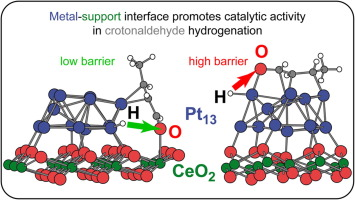Metal–support interaction effects on chemo–regioselectivity: Hydrogenation of crotonaldehyde on Pt13/CeO2(1 1 1)
The selective hydrogenation of α-β unsaturated aldehydes is of great interest in the production of fine chemicals used in perfume or pharmaceutical industry. Among the interesting products, the unsaturated alcohol is obtained by hydrogenation of the C=O double bond. The usually non-desired saturated aldehyde, which is the thermodynamically favored product, arises from the hydrogenation of the C=C double bond. During the last twenty years, plenty of experimental works have been devoted to finding efficient catalysts toward selective hydrogenations.

The metal–support interaction on the chemical reactivity is illustrated here by density functional theory calculations for the hydrogenation of crotonaldehyde on Platinum clusters deposited on CeO2(1 1 1). Adsorption of crotonaldehyde on the supported cluster is globally strengthened, compared to Pt(1 1 1), both on top of the cluster and at the interface with ceria. The activation barriers of the first and the second hydrogenation steps at both C=O and C=C double bond are consequently increased, but particularly at C=O on top of the cluster, with respect to Pt(1 1 1). In contrast, the hydrogenation at C=O double bond is far easier at the interface with ceria, which underlines the key role of the support. The considered model shows a preferential route toward the formation of the saturated aldehyde, in contrast to the measurements. This study paves the way to advanced theoretical models with larger nanoparticles supported on reduced ceria in realistic conditions of environment.
Metal–support interaction effects on chemo–regioselectivity: Hydrogenation of crotonaldehyde on Pt13/CeO2(1 1 1)
Françoise Delbecq, Yan Li, David Loffreda
Journal of Catalysis, Volume 334, February 2016, Pages 68–78.
doi:10.1016/j.jcat.2015.10.028



